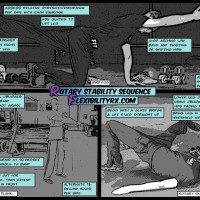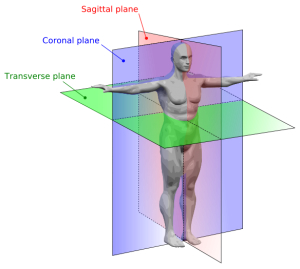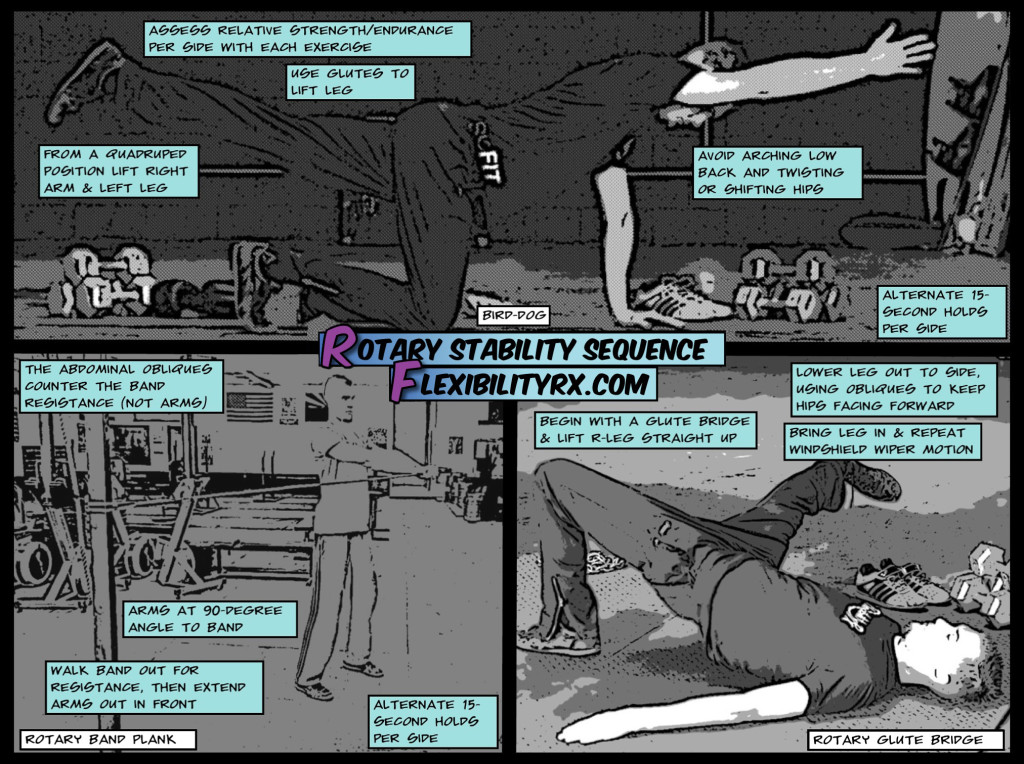
Improving Rotary Stability
Rotary stability is the ability to control rotational forces during activities like throwing, swinging, striking, kicking, and sprinting. Rotary stability is needed to resist rotation through the torso during arm and leg movements. The bird-dog for example, requires stability through the pelvis, core, and shoulder girdle during hip extension and shoulder flexion.
Rotary stability is what allows for proper motor control during complex movement patterns. While complex movements like the snatch require rotary stability, rotary stability is a component of basic developmental movement patterns like crawling.
Stability in Three Planes
Movement takes place in three planes. Developmentally we progress from the sagittal plane, to the frontal plane, to the transverse plane. Running and hip hinging are sagittal plane movements. Frontal plane movements are side-to-side, while transverse plane movements involve rotation.
Sagittal plane movements like running require both frontal plane (lateral) stability and rotary stability. The lateral stability sequence was covered here. Since many exercises in the gym involve movement through the sagittal plane (deadlifts, kettlebell swings) it is important to include supplemental exercises for rotary stability.

Gray Cook in his book “Movement” explains,
“The rotary stability test is representative of the first efficient form of locomotion for most humans, the creeping and crawling patterns in early development. These patterns demonstrate the same reciprocal movements of the arms and legs used in climbing, walking, and running.”
Core Stability versus Core Strength
Core stability is often confused with core strength. Charlie Weingroff defines stability as, “Control in the presence of change.” Core stability is different than core strength. Muscles perform different functions – the rotator cuff not only externally rotates the shoulder – but also stabilizes the glenohumeral joint. The hip external rotators externally rotate the hip and function as stabilizers of the pelvis. It is important to train muscles for their stabilizing function – bottoms up kettlebell carries for the rotator cuff and single leg exercises for the hip rotators – for example.
Certain muscles that have important stabilizing functions should be trained to resist and control movement so that proper motor control is present before strengthening exercises are added to a strength and conditioning program. Gray Cook stresses the point that athletes shouldn’t add strength to dysfunctional movement patterns.
Anti-movements are one way to train stability. Anti-extension, anti-lateral flexion, and anti-rotational movements like the front plank, side plank, and rotary band plank are an easy way to add stability training to a warm-up.
Low Threshold versus High Threshold Patterns
Another reason that stability exercises are valuable – and different than strengthening exercises – is that they are a great way to develop low-threshold strategies (soft core function). The RKC plank for example, is a high threshold strategy that teaches the total body tension needed for movements like front squats. The bird-dog on the other hand is a way to develop a low-threshold pattern for stability and postural control.
Both patterns are needed at different times – strength training often relies on high threshold patterns, while low-threshold patterns are useful to develop the stability needed for strength training. Aaron Swanson has a great blog on low versus high threshold strategies here – his explanations are listed below.
Low-Threshold Strategy: Slow, tonic, local stabilizer, stabilizing muscle contractions that are for low-load tasks and reflexive postural control. This is necessary for joint centration.
High-Threshold Strategy: Fast, phasic, prime mover, global mobilizer, mobilizing muscle contractions that are for high-load tasks and force production. This is necessary for strength training.
Different Types of Rotational Movements
Bret Contreras in this article on rotational training lists four categories of rotational exercises: general strength exercises, pure isometric rotary exercises, dynamic limb/core isometric rotary exercises, and rotary movement exercises. The rotary band hold being an isometric rotary exercise (anti-rotation) and the bird-dog is a dynamic limb/core isometric rotary exercise. Single leg exercises also fall into this category – as they train anti-rotation as well.
“Initially, most beginners possess the leg strength necessary to perform a Bulgarian split squat, however they often lack hip stability in the frontal (side to side) and transverse (rotary) planes.
If the hip stabilizers are weak or don’t fire in synchronicity, the prime movers (quads, glute max, hamstrings) won’t receive an adequate training stimulus until the hip stabilizers (adductors, glute med and min, TFL, upper glute max, hip rotators, etc.) are sufficiently strong and coordinated.” – Bret Contreras
Exercises to Improve Rotary Stability
Bird-Dog
The bird-dog is an exercise based on a crawling pattern. This quadruped pattern is utilized in both yoga and the functional movement screen. The bird-dog reveals a lot about flexibility, stability, and motor control. A step-by-step progression of the exercise can be found in this great blog by Aaron Swanson.
“The bird-dog is fantastic, because you are learning about scapulohumeral rhythm, neck packing, bracing, hip extension, lateral stability, and seeing how all these things intersect.” – Craig Liebenson
For a postural breakdown of the exercise, check out this great video by Craig Liebenson.
Rotary Band Plank
The rotary band hold is a fundamental rotary stability exercise that trains the abdominal obliques to resist rotation. This is a good way to assess fatigue resistance per side. The band used is an EliteFTS™ Pro Mini Resistance band: 41” long, 4.5mm thick, ½” wide. This band can also be used for half-kneeling face pulls, shoulder exercises, and to train the glutes.
Rotary Glute Bridge
The rotary glute bridge is an exercise I discovered on this great blog by Eric Cressy. I have renamed the exercise the rotary glute bridge. Combining hip extension with a rotary stability challenge – the exercise uses the straightened leg as resistance. Practice lowering the leg lower closer to the ground over time, the intention is resisting rotation through the torso – not the leg movement.
– Kevin Kula, “The Flexibility Coach” – Creator of FlexibilityRx™
Tags: Bird-Dog, FMS, Functional Movement Screen, Improving Rotary Stability, Rotary Band Plank, Rotary Glute Bridge, Rotary Plank Hold, Rotary Stability Exercises

Leave A Reply (No comments so far)
You must be logged in to post a comment.
No comments yet